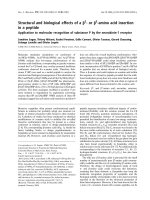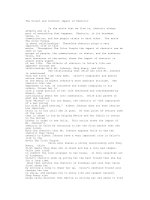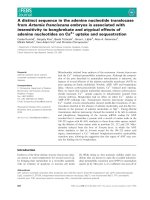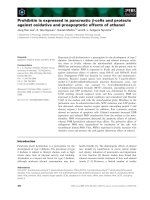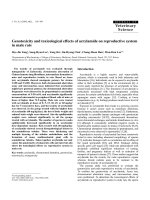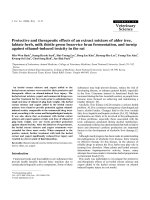investigating direct and indirect effects of variables in marketing
Bạn đang xem bản rút gọn của tài liệu. Xem và tải ngay bản đầy đủ của tài liệu tại đây (653.27 KB, 147 trang )
INVESTIGATION OF DIRECT AND INDIRECT EFFECTS
OF VARIABLES IN MARKETING
DISSERTATION
Presented in Partial Fulfillment of Requirements for
the Degree in Doctor of Philosophy in the Graduate
School at The Ohio State University
By
Sandeep Rao Chandukala
* * * * *
The Ohio State University
2008
Dissertation Committee:
Dr. Greg M. Allenby, Adviser
Dr. H. Rao Unnava
Dr. Robert E. Burnkrant
Approved by
___________________________________
Adviser
Business Administration Graduate Program
ii
ABSTRACT
The idea of hierarchical, sequential, or intermediate effects has long been posited
in textbooks and academic literature. Hierarchical effects occur when relationships
among variables are mediated through other variables. Despite the attractive theoretical
properties of these models, their practical existence has been difficult to show in
empirical studies. This thesis comprises of three essays where we demonstrate the
presence of hierarchical effects and propose methods for detecting and measuring these
effects. The first two essays use empirical data to demonstrate our methodology and its
extensions, while the third essay uses three experimental studies to demonstrate the
hierarchical effects and role of memory associations impacting consideration sets.
In the first essay, we propose an approach to studying hierarchical effects using
sets of conditional relationships among affected variables while allowing for
heterogeneous response segments, and using Bayesian variable selection to deal with the
high dimensional parameter space often resulting in applied empirical studies. Cross-
sectional data from a national brand-tracking study is used to illustrate our model, where
we find empirical support for a hierarchical relationship among media recall, brand
beliefs, and intended actions. We find these effects to be insignificant when measured
with standard models and analyses. The proposed model is useful for understanding the
iii
influence of variables that lead to intermediate, as opposed to direct effects on brand
choice.
The second essay proposes a methodological extension to the first essay by
extending it to panel data. We investigate through a series of quantitative models the role
played by customer wait times at a teller and its relationship with the overall satisfaction
in a retail banking environment. We demonstrate that accounting for heterogeneous
segments of branches provides a better understanding of the drivers of overall
satisfaction. Customer wait times impact the drivers of customer satisfaction that result
in impacting overall satisfaction. We provide managerial insights by incorporating a
threshold parameter in the model that determines average time that a customer is willing
to spend waiting at a bank and its impact on overall satisfaction.
The third essay incorporates the benefits sought by consumers into network
models of memory. Prior consumer research in network models of memory has primarily
focused on the association between brands and attributes. The concept of benefits sought
by consumers has not been integrated into these models. We propose a model of memory
organization that explicitly recognizes the distinction between brand attributes and
desired benefits and study the impact of advertising on this proposed network. The model
we advance includes nodes representing benefits sought by consumers that are linked to
brand attributes and brand names. We demonstrate, using three studies, that advertising
effectiveness increases when the advertising message taps into an individual's desired
iv
benefits. Understanding the cognitive associations between desired benefits and brand
attributes can help marketers design more effective communications.
This thesis contributes new methodological approaches for exploring hierarchical
effects among variables in marketing. Essay one proposes a Bayesian approach for
analyzing hierarchical effects in cross-sectional data which can easily be extended and
applied to mediation analysis. Essay two demonstrates the importance of our proposed
modeling approaches with application in services literature. Essay three contributes to
the existing literature on associative networks by incorporating an additional layer that
accounts for desired benefits and demonstrates the significant role played by the
associations in a hierarchical memory network on forming consumer consideration sets.
v
ACKNOWLEDGMENTS
I wish to express sincere thanks to my adviser, Dr. Greg M. Allenby, for the time
and effort he put into my doctoral education. I truly believe that I have benefited both
academically and personally from my association with Greg. He has instilled in me
something he truly believes in, to be rigorous in research.
I would also like to thank Dr. H. Rao Unnava for his invaluable help and patience in
guiding me through entire experimental design research. I am grateful to Dr. Robert E.
Burnkrant for his insightful comments that helped fine tune my research. I would also
like to thank Dr. Thomas Otter for his encouragement during my doctoral program.
I could not have completed my doctoral studies without the consistent support of
my family and friends and I am indebted to them. I would also like to thank all the
current and past doctoral students who helped me through my research work. Finally, I
would like to thank Cindy Coykendale and Lisa Gang for their help in navigating through
all the administrative details.
vi
VITA
October 16, 1975 Born – Hyderabad, India
1997 B.E., Instrumentation Engineering
Osmania University, Hyderabad, India
1999 M.S., Computer Engineering
University of Minnesota, Twin Cities, MN, USA
2002 M.B.A,
University of Texas, Dallas, TX, USA
2003 M.S., M.A.S
University of Texas, Dallas, TX, USA
2003-present Graduate Teaching and Research Associate,
The Ohio State University
FIELDS OF STUDY
Major Field: Business Administration
Specialization: Marketing
vii
TABLE OF CONTENTS
Page
Abstract ii
Acknowledgements v
Vita vi
List of Tables ix
List of Figures xi
Chapters:
1. Introduction 1
2. Essay 1: Bayesian Analysis of Hierarchical Effects 5
2.1 Introduction 5
2.2 Model 9
2.3 Simulation Study 17
2.4 Data 19
2.5 Results 20
2.6 Discussion 25
2.7 Conclusion 29
3. Essay 2: Bayesian Investigation of Service Wait Times 48
3.1 Introduction 48
3.2 Data 50
3.3 Model Specifications 51
3.4 Results 58
3.5 Discussion 62
3.6 Summary 65
4. Essay 3: Incorporating Desired Benefits into Network Models of Memory 74
4.1 Introduction 74
4.2 Product attributes and benefits 75
4.3 Proposed memory network 77
4.4 Study 1 81
4.5 Study 2 91
viii
4.6 Study 3 96
4.7 Discussion 100
5. Conclusions and Future Research 111
Appendices 117
Appendix A: Estimation algorithm for Essay1 117
Appendix B: Estimation algorithm for HB threshold model 122
Appendix C: Ad for Study 1 125
Appendix D: List of statements and response scales (Study 1 and Study 2) 126
Appendix E: Ad for Study 2 129
List of references 130
ix
LIST OF TABLES
Table Page
2.1 Model Description 35
2.2 Coefficient Estimates for Homogeneous Regression Model Simulated Data 36
2.3 Coefficient Estimates for Normal Mixture Model Simulated Data 37
2.4 Coefficient Estimates for Finite Mixture Model Simulated Data 38
2.5 Descriptive Statistics for Automobile Data (N = 6178) 39
2.6 Aggregate Regression Coefficient Estimates Automobile Data 40
2.7 Naïve Segment Regression Estimates 41
2.8 Coefficient Estimates for Naïve Aggregate Model using Multivariate
Regression 42
2.9 Model Fit 43
2.10 Sub-model model Fit 43
2.11 Direct Effects of Media Exposure, Brand Beliefs and Intended Actions
on Purchase Intention {β
k
} 44
2.12 Effects of Brand Beliefs on Intended Actions {Γ
k
} 45
2.13 Effects of Media Exposure on Brand Beliefs {∆
k
} 46
2.14 Aggregate Effect of Media Exposure (Z) on Purchase Intention (y) 47
3.1 Branch level Descriptive Statistics for Retail Banking Data
(N = 1748 branches) 70
3.2 Correlation matrix for the variables in retail banking data 70
x
3.3 Model fit comparisons for retail banking data 71
3.4 Influence of Wait Times on Perceived Service Drivers (Mean Effects) –
Standard HB model 71
3.5 Influence of Wait Times on Perceived Service Drivers
(Unobserved Heterogeneity) – Standard HB model 71
3.6 HB mixture model for Retail Banking Data (N = 1748 branches) 72
3.7 HB threshold model for Retail Banking Data (N = 1748 branches) 73
4.1 Variables Collected in the Initial Survey before Viewing the Advertisement 107
4.2 Number of Subjects Considering Puma for Purchase – Study 1 109
4.3 Ratings for Attributes Not Included in the Advertisement – Study 1 109
4.4 Number of Subjects Considering Puma for Purchase – Study 2 110
4.5 Number of Subjects Considering Puma for Purchase – Study 2 110
4.6 Mean Reaction Times for the Subjects Response to Key Statements – Study 3 110
4.7 Mean Reaction Times – Hierarchical Memory Organization – (Respondents
from Study 1) 111
xi
LIST OF FIGURES
Figure Page
2.1 Trace Plot of Segment Weights for Homogeneous Regression Model Simulated
Data 32
2.2 Trace Plots of Segment Weights for a Three-Component Mixture Model with
K = 4 Simulated Data 33
2.3 Trace Plot of Segment Weights for Automobile Data with K = 4 34
3.1 Influence of Wait Times on Perceived Service Drivers Data and Posterior
Distributions 67
3.2 Trace Plot of Segment Weights for Bank Data with K = 4 68
3.3 Trace Plot of Cutoff parameter for Bank Data 69
4.1 Proposed Hierarchical Memory Network 104
4.2 Subjects pool for studies 104
4.3 Associative Network for Respondents in Study 1: Before viewing the Ad 105
4.4 Associative Network for Respondents in Study 1: After viewing the Ad 105
4.5 Associative Networks for Respondents in Study 2 106
4.6 Associative Networks for Respondents in Study 3 106
1
CHAPTER 1
Introduction
Advertising variables, such as media exposure, are often introduced into models
of consumer behavior as regressors in linear models. The role of advertising, however, is
more subtle. Advertising can initiate intermediate actions, like seeking additional
product information, impact brand beliefs and it can effect consideration sets that later
lead to purchase. Models that attempt to measure advertising relationships as the direct
link to purchase may under-estimate effect-sizes by overstating its role. Consumers at
different stages of the buying decision may differ in the type and degree to which
marketing activities influence their behavior. The purpose of this thesis is to better
understand and develop models for measuring the direct and indirect or intermediate
effects of commonly encountered variables in marketing data.
There are two main themes to this dissertation. First, to propose a methodology to
capture hierarchical effects between various variables, extend this methodology and
demonstrate using empirical applications the relevance and significance of the proposed
approaches. For example, in the first essay we demonstrate the direct and intermediate
effects of media and brand beliefs on purchase intention. Second, use an experimental
setup to understand the impact of advertising on consumer memory associations (in a
hierarchical network) that lead to changes in the consideration set. In both these cases,
2
we find that advertising impacts the outcome variable (purchase intention in one, and
brand consideration set in the other) through intermediate variables (consumer actions
and brand beliefs in one and attribute-benefit associations in the other).
The thesis comprises three essays. The first essay demonstrates the problems
with ignoring the impact of media exposure on intermediate intervening consumer
actions. The analysis of media effects in the presence of a staged decision process
requires models that allow for response segments affected by different variables. We
propose a method that simultaneously pools respondent data into segments that differ in
the likelihood of purchase and its association to intermediate actions, brand beliefs and
media exposure. Models that acknowledge the presence of response segments with
different behavior patterns and associated variables are known as models with structural
heterogeneity. Our proposed method accounts for structural heterogeneity by using a
normal mixture model. While the intermediate consumer action variables are related to
brand beliefs and brand beliefs to media exposure variables using auxiliary multivariate
regressions. We deal with the issue of model dimensionality using Bayesian multivariate
variable selection. We demonstrate the significance of our methodology using an
empirical application from a national brand tracking study (cross-sectional data) for
luxury automobiles.
The second essay proposes an extension to the Bayesian hierarchical model of
essay 1 to panel data in a retail banking environment. We propose three different model
3
specifications to understand the impact of customer waiting times on drivers of
satisfaction and overall satisfaction in the context of retail banking. The first model,
Standard HB model, investigates the moderating effect of mean waiting time before and
after reaching a teller on drivers of satisfaction (like courtesy and friendliness, undivided
attention of the teller etc.) and overall satisfaction. This model accounts for preference
heterogeneity only. The second model, HB mixture model, incorporates preference and
structural heterogeneity where different heterogeneous segments are determined by the
relationship between the drivers of satisfaction and overall satisfaction. We account for
structural heterogeneity in the data by modeling a mixture of likelihoods as opposed to a
single likelihood function. We determine whether, overall satisfaction or waiting times,
differentiate the different response segments. The third model, HB threshold model,
extends the second model by incorporating a threshold parameter that determines the
average cutoff time that consumers are willing to wait beyond which it has a significant
impact on overall satisfaction. This model has significant managerial implications
because it provides a concrete measure of a cutoff time that branch managers can actually
use as guidance for taking appropriate actions to help improve the overall satisfaction of
the bank. Thus, in essay 3 we study the indirect effects of wait times on overall
satisfaction.
The third essay focuses on understanding how advertising works based on
associative memory networks. We integrate the concept of benefits sought by consumers
4
along with attributes and brands into a network model of memory. We propose and test
the presence of a memory structure linking benefits with attributes and brands, and show
that advertising effectiveness increases when the advertising message taps into an
individual's desired benefits or concerns. Understanding the cognitive associations
between benefits and brand attributes can help marketers design more effective
communications. The implications of such a representation of brand information in
memory are studied in two experiments.
This thesis is geared toward understanding and developing models for measuring
direct and indirect effects of variables. In: essay 1, impact of media exposure on
purchase intention, essay 2: impact of wait times on overall satisfaction and essay 3:
impact of attribute efficacy associations on consideration set. The common underlying
finding in all the essays is: not accounting for indirect effects of variables can mask the
true impact and underestimate the effects of commonly encountered variables in
marketing. The remainder of this thesis is organized as follows. In chapter 2, the first
essay “Bayesian Investigation of Hierarchical Effects” is discussed. The second essay, an
extension to essay 1, “Bayesian Investigation of Service Wait Times” is discussed in
chapter 3. Chapter 4 presents the third essay “Incorporating Benefits into Network
Models of Memory”. Conclusions and future extensions of this thesis is presented in
chapter 5.
5
CHAPTER 2
Essay 1: Bayesian Analysis of Hierarchical Effects
2.1 Introduction
Models of consumer decision process are a fixture of marketing textbooks (Boone
and Kurtz 2007; Kotler and Keller 2005; Blackwell, Engel, and Miniard 2001; Howard
and Sheth 1969). Consumers are believed to move through several distinct stages of
behavior beginning with the recognition of a need and terminating with choice and post-
purchase evaluation. Advertising and consumer behavior textbooks are also replete with
examples of models that relate advertising to consumer outcomes through a hierarchical
or sequential process (e.g., Vakratsas and Ambler 1996; Assael 1993). The AIDA
framework (E. St. Elmo Lewis 1898; Strong 1925) is one of the earliest and best known
examples, where advertising impacts choice through a specific, sequential process: from
attention to interest to desire to action. Lavidge and Steiner (1961) extend this process to
include knowledge, liking, preference, conviction, and ultimately, purchase. Recent work
has attempted to generalize these early advertising effects models by couching them in
terms of cognition, affect, experience, and action (Vakratsas and Ambler 1999; Holbrook
and Batra 1987). Although they differ in form, most models adhere to the general notion
that consumers first learn, and then know, feel and do.
These extended models of behavior point to the idea of hierarchical effects, where
influences between variables are mediated by other variables. Thus, the effects of
6
knowing on doing are assumed to be mediated, at least in part, by variables that reflect
feelings and affect. This chapter proposes a Bayesian approach to studying hierarchical
effects such as these. Hierarchical effects are modeled by expressing the joint
distribution of variables under study as a set of marginal and conditional distributions.
Thus, for three sets of variables (A,B,C), we can write the joint distribution [A,B,C] in
terms of various factorizations. The model [A,B,C] = [A|B][B|C][C] indicates that B
mediates the influence of C on A, whereas the model [A,B,C] = [A|B,C][B][C] indicates
that both B and C directly influence A. In these expressions, the vertical bar "|" stands
for the conditioning argument, and the bracket notation implies a distribution.
A challenge in the analysis of hierarchical effects is the large numbers of
variables present that reflect diverse aspects of behavior. Consider, for example,
individuals engaged in the process of buying a new car. When first entering the market,
they may engage in an extensive information search to identify available products and
their corresponding attributes. The variables at this stage include media viewership and
advertising recall. As preferences develop and consideration sets are formed, individuals
may become increasingly sensitive to direct appeals attempting to initiate purchase.
Possible variables include the use of electronic and direct postal mail. These variables
may also influence a set of intended actions, such as dealer visits, and may influence the
formation of brand beliefs, all of which may precede actual vehicle purchase.
7
Our approach to analyzing hierarchical effects in extended models of behavior is
to employ three known aspects of modern Bayesian analysis. First, as stated above, we
express hierarchical effects in terms of probability statements about the joint distribution
of the data. In the model [A,B,C] = [A|B][B|C][C], the variable A is conditionally
independent of C given B. All information from C that affects A must flow through B.
Conditional independence is a basic assumption of modern Bayesian analysis (Bernardo
and Smith 1994), including hierarchical Bayes models (Rossi, Allenby and McCulloch
2006). Our approach, however, differs from the typical hierarchical Bayes model in
marketing, where interest focuses on explaining variation in effect sizes using random-
effects models. Instead, we propose tools to investigate hierarchical effects among
variables, not among coefficients.
Second, our model allows for heterogeneous segments that differ in terms of
response coefficients and error variance. We employ the Bayesian method of data
augmentation (Tanner and Wong 1988) to identify respondent segment memberships that
greatly simplify high-dimensional calculations associated with these models. Third, our
model uses Bayesian variable selection (McCulloch and George 1993) to help reduce the
high-dimensional mapping between sets of variables. We show that both model aspects
are needed for our data.
Our model generalizes a statistical procedure commonly known as "mediation
analysis" (Baron and Kenny1986), where a series of estimated regression relationships is
8
used to assess the presence of a hierarchical relationship. Traditional mediation analysis
involves using standard regression procedure and comparing effect sizes across different
combinations of variables. More recently (Iacobucci et al. 2007), propose using
structural equation models to be a superior option than traditional approaches in that it
can handle additional construct into the mediating system. Our approach is more flexible
in that it can be used to compare hierarchical effects across multiple levels and across
models that differ by more than the inclusion of a regression variable.
We investigate the relationship among purchase likelihood, intended consumer
actions, brand beliefs and media exposure using cross-sectional data for a high-end
luxury automobile. We find the presence of response segments that differ in their
likelihood of purchase and its association to the other variables. Results from our model
indicate that media effects, after accounting for the presence of heterogeneous response
segments, are large and change in magnitude as the likelihood of purchase increases. We
also find evidence supporting a decision process in which media has direct and indirect
(through brand beliefs) effects on likelihood of purchase. Analysis that fails to account
for heterogeneous response segments is shown to grossly under-estimate the effectiveness
of media.
The remainder of the chapter is organized as follows. Section 2.2 presents a
Bayesian model for estimating heterogeneous hierarchical effects with a prior
specification that facilitates variable selection. A simulation study is presented in Section
9
2.3 to demonstrate key features of the proposed method. Section 2.4 describes the data
used to investigate different hierarchical effects, and results are presented in Section 2.5.
Section 2.6 contains a discussion of the results, and Section 2.7 offers concluding
remarks and discusses limitations of our analysis.
2.2 Model
Hierarchical effects models of consumer behavior and advertising are particularly
important in the context of high-involvement goods and services where substantial,
prolonged consideration occurs prior to purchase. An initial stage of information search
is typically posited as a set of considered brands is formed, and then additional
information is sought as preferences are developed, brands are ranked and choices are
made. If consumers do engage in a staged decision process, it is likely that their
sensitivities to advertising and other, experiential, activities differ according to their
relative stage in that process.
The analysis of media effects, brand beliefs and consumer actions in the presence
of a staged decision process requires models that allow for response segments affected by
different variables. Models that acknowledge the presence of response segments with
different behavior patterns and associated variables are known as models with structural
heterogeneity. Structural heterogeneity models have been used in marketing to study the
order in which different consumers process attributes in purchasing grocery items
(Kamakura, Kim and Lee 1996), the evaluation of credit card offers and its relationship to
10
a consumer's current balance (Yang and Allenby 2000), and the presence of conjunctive
versus disjunctive screening rules in conjoint analysis (Gilbride and Allenby 2004).
Structural heterogeneity models employ a finite mixture of likelihoods, in contrast to
standard heterogeneity models that assume one likelihood function is sufficient for
describing all respondents.
Our models for investigation of hierarchical effects relates an intent-to-purchase
measure (y) to a series of intended consumer actions (X), brand beliefs (B) and media
exposure variables (Z). We use capital letters (e.g., X) to denote a set of responses by
collections of individuals, and lower-case letters (e.g., x
i
) to denote the response from a
specific individual indexed by the subscript "i." The intent-to-purchase measure, y, is a
single item and is represented in lower-case (y and y
i
). We consider a variety of
relationships among these variables as described in table 2.1. The second column of table
2.1 provides a symbolic description of the model using the bracket notation described
above. The third column of table 2.1 highlights the conditional relationship for the
intent-to-purchase variable, and column four indicates variables for which a marginal
distribution is assumed.
Model 1 posits a conditional relationship between purchase intent (y) and
intended consumer actions (X), with marginal distributions for actions (X), brand beliefs
(B) and media exposure (Z). Thus, brand beliefs and media exposure data are not
assumed to have a direct or indirect affect on purchase intention. Model 2 includes brand
11
beliefs (B) with actions (X) in the model for purchase intentions, and model 3 also
includes media exposure information (Z). Thus, models 2 and 3 assume direct
relationships between purchase intent and its antecedents. Model 4 posits a series of
conditional relationships among the variables where media exposures (Z) influence
beliefs (B), which in turn influence actions (X), and then actions affect purchase intent
(y). Models 5 and 6 reflect two variations on the hierarchical effects model, with model 5
removing the hierarchical influence of media exposures (Z) and model 6 assuming the
media has a direct affect on actions (X).
Consider model 4, where hierarchical effects are assumed to exist among each
set of variables: [y|X][X|B][B|Z][Z]. We introduce heterogeneous response segments in
the first factor in the model by assuming a finite mixture of likelihoods:
{ } ( )
2 2
1
| , , , ~ ,
K
i i k k k k i k k
k
y x N x
φ β σ φ β σ
=
′
∑
(1)
where k is an index for the response segments with relative size
k
φ
and
1.
k
k
φ
=
∑
Equation (1) implies that an arbitrarily selected respondent belongs to one of K response
segments, each of which is related to the consumer actions through segment-specific
regression coefficients β
k
and error variance σ
2
k
. Our model differs from a traditional
finite mixture model (Kamakura and Russell 1989) by allowing the error variance to be
12
segment-specific. We illustrate the importance of this assumption in our simulation study
below.
Equation (1) is used to identify the K response segments using a hierarchical
Bayes model that augments the parameter space with latent indicator variables, s
i
, used to
simplify calculations (see Rossi, Allenby and McCulloch 2005 chapter 5). At each
iteration of the Markov chain used to estimate the parameters in equation (1), latent
indicator variables {s
i
} are drawn from multinomial distributions. These latent variables
are used to assign each observation to a response segment k = 1,…, K. Given these
indicator variables, the regression coefficients
{
}
2
,
k k
β σ
are estimated using a series of
independent models for each of K datasets A
k
, k=1,…,K where A = A
1
∪ A
2
∪ … ∪ A
K
denotes the entire set of data. Details of the estimation procedure are provided in the
appendix A.
The brand belief variables (B) are related to intended consumer action variables
(X) through independent auxiliary multivariate regression models for each response
segment:
(
)
(
)
kikikkii
bNksbx ΣΓ=ΣΓ ,~,,,| (2)
Similarly, media exposure variables (Z) are related to brand belief variables (B), through
independent auxiliary multivariate regression models for each segment:
13
(
)
(
)
kikikkii
zNkszb Ω∆=Ω∆ ,~,,,| (3)
where the regression coefficients (Γ
k
and ∆
k
) and error covariance matrix (Σ
k
and Ω
k
) are
segment-specific. All models (except model 2 and model 3), assume that the response
segments (k) are determined entirely by the relationship between consumer actions (X)
and purchase intention (y) in equation (1). Equations (2) and (3) are only used to
characterize these segments. This assumption, however, is not a requirement of our
general approach to study hierarchical effects, and is made in anticipation of our
empirical results.
An advantage of our assumed segment structure described by equations (1), (2)
and (3) is that it does not necessarily require the presence of media effects (∆) for a
staged decision process to exist. Some media may be ineffective at driving some of the
brand beliefs and some of the brand beliefs may be ineffective in driving the consumer
actions, and we believe this lack of relationship (i.e., elements of Γ and ∆ equal to zero)
should not be used as a basis for identifying the latent segments. We recognize that this
is a strong assumption and therefore propose two alternate models (models 2 and 3) in
which the assumption is relaxed. In model 2, we assume that the response segments are
determined not only by consumer actions and purchase intent but by brand beliefs as
well. Model 3 assumes that response segments are determined by consumer actions,
